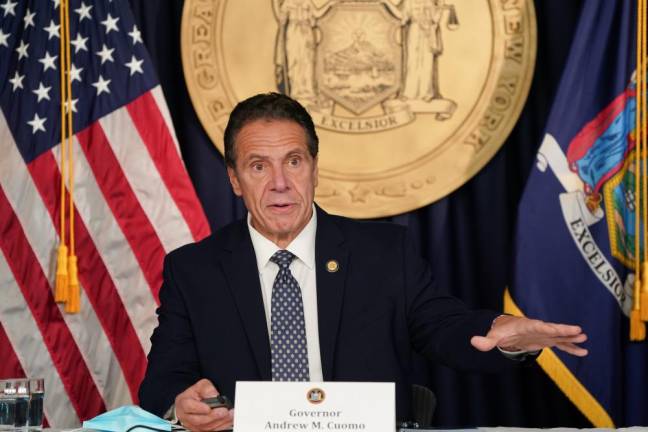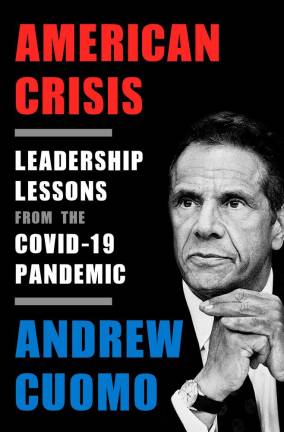At the end of grueling days battling the pandemic, Andrew Cuomo would lay in bed and discuss with his father the decisions he had made. “I would list a fact pattern and ask him what he thought,” Cuomo writes in his new book, “American Crisis: Leadership Lessons From the COVID-19 Pandemic.”
Of course, his father, Mario M. Cuomo, the former governor of New York, died on New Year’s Day, 2015, as his son began his second term as governor. So after presenting that day’s COVID challenges to his father, Andrew explains, “then I would provide his analysis.”
This scene is both poignant and painfully Cuomoesque. Andrew Cuomo hastens to explain this was an exercise, not a modern restaging of Hamlet, in which Mario Cuomo’s ghost haunts the Governor’s mansion.
Nevertheless, his father’s voice hovers above every page of this chronicle. “Omnipresent with my father was the principle of responsibility,” Cuomo writes. “You ran for office and asked people for the job, and they vested you with authority. Respect your authority and do not demur. Don’t make excuses. Step up; do not step away. Trust the People; don’t think that you are smarter than they are. Tell them the truth, and they will do the right thing.”
Many of us who knew and admired Mario Cuomo recognized that his skill at communicating the challenges of government exceeded his success at executing the solutions. We campaign in poetry, he would explain, and govern in prose.
His son makes clear he is determined to exceed the father by being both the great communicator and the effective executive. His book covers a period of about four months during which the coronavirus crept into his state, inflicted a horrible toll but was tamed through the courage of New Yorkers and the leadership of Andrew Cuomo.
If Mario Cuomo is the polestar of this story, another New Yorker, Donald Trump, is the dark void, the place where facts and reason go to die. Cuomo asks us to see the year as a clinical trial of two competing views of government “tested in the laboratory of reality.”
“Trump’s theory was to deny the existence of the virus and, when that didn’t work, act as if it were irrelevant and reopen the economy immediately,” Cuomo writes. “Our theory was that a virus requires a science-based solution and that a phased, data driven reopening was smarter and better in the long run.”
A day in the life of this pandemic consisted for Andrew Cuomo of studying up for the governor’s late morning briefing, which developed a national viewership of millions, followed by an afternoon of searching out solutions for problems no one had faced before.
“The MTA and I identified the right cleaning contractors and chemicals,” he reports in a chapter describing his decision to close the subways overnight to decontaminate them.
Cuomo acknowledges his proclivity for control, a characteristic he inherited, whether through nurture or nature, from his father.
With urgent cases rising, a doctor in Detroit has an idea for putting four patients on one ventilator. “I called her,” the governor relates, as if this were a routine role for the Governor of a state of 19-million people. “The detective work of contact tracing fell to me,” he explains at another point about a family infection scare.
He personally tests an idea to use rubber bags to help Covid patients breathe. “I tried to squeeze the bag for a period of time and thought, this is never going to work,” Cuomo writes. “We were desperate. I was desperate. Here we were in the greatest country in the world talking about squeezing rubber bags to keep people alive.”
Vital Source Document
So how did it get this bad? Governor Cuomo was a key witness to – and, by some partisan accounts, a participant in – one of the worst governmental failures in American history. So his account of the pandemic is a vital source document as we try to understand what went wrong.
Cuomo himself compares the failure to halt the coronavirus to the failure to stop the Japanese attack on Pearl Harbor, a notorious example of intelligence breakdown and poor communication between military and government officials.
Similar breakdowns were revealed sixty years later, after another attack, this one on the World Trade Centers and the Pentagon. Yet in between, Albert Camus, in his book, “The Plague,” suggested that the existential reason history repeats itself this way is because we are who we are.
By bringing up Pearl Harbor, Cuomo raises a bar for his book that he doesn’t quite get over. What went wrong? He asks and answers. The country was divided which allowed Trump to reach office. And Trump had neither interest in or skill at governing.
Cuomo offers a series of scenes to illustrate the malfeasance of the White House. He “remembers dropping my fork” during dinner at the governor’s mansion watching Trump announce he had “total authority” to order states to reopen their economies, a Constitutional absurdity that no Governor Cuomo, pere or fils, could allow to stand.
This is fine as far as it goes. Perhaps we can’t expect more from a Democrat before election day. But a true grasp of the lessons of the pandemic require more than enumerating the failings of Donald Trump, as extensive as they have been.
Cuomo comes closer to the full story when he describes how “every time I watched an ‘expert’ on TV pontificating, I wanted to yell ‘why didn’t you know the virus left China and went to Europe last year!’ What a glaring mistake.”
Striking Omission
But contrary to his reputation for pursuing every detail, Cuomo never follows up the point. In fact, he doesn’t even quote himself from earlier in the year when he demanded to know where the media was in the early days of the pandemic, a point made all the more salient by what we have since learned about Trump telling Bob Woodward in early February that he knew the virus was dangerous and spreading.
Cuomo castigates Trump for his racist language about the China Virus. But he does not delve the weeks of delay by the Chinese government in sounding the alarm as the virus spread in China.
Closer to home, there is a striking omission. The New York City Health Department was once thought of as the finest local health department in the world. In 1947 it spotted a potential smallpox infection brought from outside the country and inoculated 6 million residents in less than a month.
Why was the New York City Health Department able to perform then but not this time? They are absent from the Cuomo chronicle, for good or ill.
Perhaps part of the reason for this omission is what Cuomo acknowledges to be his “problematic” relationship with Mayor Bill de Blasio. He doesn’t mention de Blasio much, saving to the end a denunciation that more than anything else in the book feels like a statement meant for future Democratic party politics, say the 2024 presidential nominating process.
De Blasio, Cuomo writes, is a “faux progressive,” which he explains as, “officials who believe being a progressive is merely a function of advocacy and posturing. Faux-progressive officials advocate but never accomplish.”
This gap reinforces “public cynicism that government change never happens and positive results are never the outcome,” Cuomo writes. “Conservatives win when government fails to make positive change.”
“We must prove government can work,” Cuomo writes.
How Cuomo’s distinction between mere advocacy and effectiveness will play in a Democratic party moving rapidly left will be an important narrative to follow. But Cuomo does share one verdict already in on his work.
After months of separation, Andrew Cuomo finally gets to see his mother, Matilda, spouse for 60 years of Mario Cuomo. She had pages of notes she had kept while watching Andrew’s daily briefings. But she had one main point. “She wanted me to know that they were both proud. Your father is proud, ‘so proud,’ she said repeatedly.”
“Trust the People; don’t think that you are smarter than they are,” Cuomo writes. “Tell them the truth, and they will do the right thing.”

